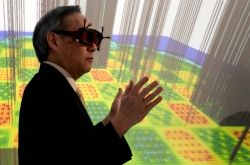
Secretary Chu stops at Oak Ridge National Lab in February 2012 for a quick, nuclear-themed visit that included a tour of the Consortium for Advanced Simulation of Light Water Reactors (CASL) and a stop at the new Manufacturing Demonstration Facility (MDF). | Photo courtesy of Oak Ridge National Lab
Editor's note: This article has been updated to reflect the name and URL changes of the Greater Philadelphia Innovation Cluster (GPIC) for Energy-Efficient Buildings to the Energy Efficient Buildings Hub.
If you could build a team of the best researchers and engineers in the United States to achieve major energy goals, what would they be? Two years ago, the creation of the Energy Innovation Hubs provided exactly that opportunity.
In 2010, the first Energy Innovation Hubs began operations with some of the top scientists from academia, industry, and government charged to collaborate and overcome known barriers in energy technology. The first three hubs focused on how to build more-efficient nuclear reactors, design more energy efficient buildings, and produce biofuel from the sun.
Modeled after the concentration of brainpower and resources that defined the Manhattan Project, these integrated research centers combine basic and applied research with engineering to accelerate scientific discovery in these critical energy issues.
The Modeling and Simulation for Nuclear Reactors Hub is using supercomputers to create “virtual” reactors that will help improve the safety and performance of both existing and new nuclear reactors. The models produced will then help address significant operational and safety issues identified by the nuclear industry, like localized corrosion and cladding integrity during a loss of cooling accident. As a result, capital and operating costs per unit of energy can be reduced through improved efficiency. Efficiency upgrades could also mean enabling higher fuel burn-up, which would reduce the amount of nuclear waste left over. Eventually, the virtual modeling could even help nuclear engineers as they work develop the next generation of nuclear reactors.
The Fuels from Sunlight Hub hopes to find a way through their research to emulate the process of photosynthesis, the process by which plants turn light into energy. The goal of this hub is generating new liquid fuels using only materials that are plentiful - like sunlight, water, and carbon dioxide. This development would go a long way toward making solar fuels an accessible, reliable, and sustainable successor to petroleum-based fuels, reducing American dependence on foreign oil.
The Energy Efficient Buildings Hub focuses on a whole and integrated systems approach to buildings rather than individual buildings systems (like heating, air conditioning, or windows). One of the initial tasks of the Hub is pioneering new data intensive techniques for designing and operating energy efficient buildings, including advanced computer modeling. The EEB Hub will use the data it collects over time as it attempts to find new, accurate, and cost-effective ways to assess existing buildings and ways to make them more energy efficiency overall. Through their work, JCAP expects to cut energy use in the U.S. building sector in half within 20 years.
Congress funded two more hubs this year. The Batteries and Energy Storage Hub will focus on accelerating research and development of electrochemical energy storage for transportation and the electric grid. The Critical Materials Hub will primarily focus on enhancing the domestic supply of materials critical for energy technology systems and reducing the quantities of those materials necessary for manufacturing and deploying those systems.
Together the five hubs will shorten the path from laboratory innovation to technological development, and lead the way toward American competitiveness, economic growth and energy security.

